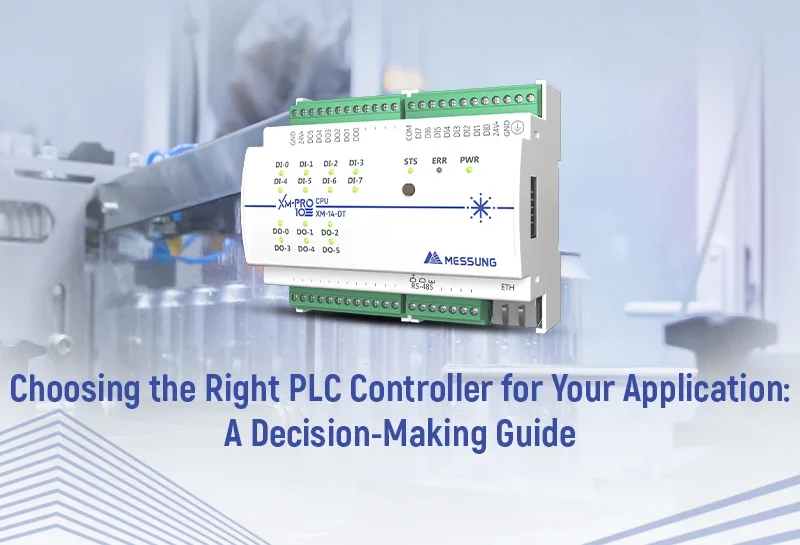
In today’s rapidly evolving world of industrial automation, the right Programmable Logic Controller (PLC) can be the linchpin of a successful operation. These versatile devices are the workhorses of modern manufacturing, providing the control and precision needed to keep everything running smoothly. When it comes to choosing the right PLC controller for your specific application, the task can be daunting. In this guide, we will walk you through the essential steps to make an informed decision.
Introduction to Messung Automation
Before we delve into the intricacies of PLC controllers, it’s essential to understand the significance of Messung Automation and its role in industrial automation. Messung Automation, a leading name in the industry, offers a wide range of PLC controllers and automation solutions. Our commitment to innovation and quality has made us a trusted partner for industries across the globe.
Understanding PLC Controllers
A PLC or Programmable Logic Controller, is a specialized computer used in industrial control systems. It plays a pivotal role in automating tasks, monitoring processes, and ensuring safety. PLC controllers are at the heart of modern manufacturing, managing tasks from simple lighting controls to complex assembly line operations.
PLCs are designed to be robust and reliable, capable of functioning in harsh industrial environments. They execute control functions based on user-defined logic and can communicate with other devices and systems, ensuring seamless automation.
For More Information about PLC read our blog: UNDERSTANDING PROGRAMMABLE LOGIC CONTROLLERS.
Identifying Your Specific Needs
The first step in selecting the right PLC controller is understanding your specific needs. Your automation requirements will depend on the type of industry, the complexity of your processes, and your long-term goals. Key factors to consider include:
- Scale of Automation: Are you automating a single process or an entire production line?
- Environmental Conditions: Is your facility exposed to extreme temperatures, humidity, or corrosive elements?
- Safety Requirements: What safety features and redundancy do you need to ensure the well-being of your workforce and the integrity of your processes?
- Connectivity: Will the PLC need to communicate with other devices, systems, or be part of an Industrial Internet of Things (IIoT) setup?
These questions will help you define the scope of your project and determine the features your PLC controller should have.
Exploring PLC Options
Now that you have a clear understanding of your needs, it’s time to explore the diverse world of PLC controllers. Messung Automation provides a comprehensive range of PLC controllers, offering solutions for various industries and applications.
Here are the features to consider:
- PLC Types: There are various types of PLCs, including compact, modular, and rack-mounted. The choice will depend on your application’s specific requirements.
- Scalability: Choose a PLC that can be expanded to accommodate future growth and changes in your processes.
- Customization: The PLC manufacturer should offer customization options to meet unique requirements.
Comparing Features and Specifications
Once you’ve narrowed down your options, it’s time to compare the features and specifications of different PLC controllers. Look into:
- Processing Power: The speed and capacity of the PLC’s processor, which affects its ability to handle complex tasks.
- I/O Count: The number and types of input and output points available.
- Communication Protocols: Compatibility with the communication protocols used in your facility.
- Programming Interface: The ease of programming and user-friendliness of the interface.
By carefully analyzing these aspects, you can ensure that the PLC controller you choose aligns with your specific needs and provides the necessary capabilities for your automation project.
The Decision-Making Process
With a wealth of information in hand, it’s time to synthesize your findings into a structured decision-making process. This process should guide you through the final steps of selecting the right PLC controller for your application.
- Define Your Goals: Clearly outline your automation goals and objectives.
- Prioritize Needs: Rank your requirements in order of importance.
- Evaluate Options: Compare the features and specifications of different PLC controllers.
- Consider Budget: Ensure the chosen PLC controller aligns with your budget constraints.
- Consult with Experts: Seek advice from experts or automation consultants, if necessary.
- Testing and Validation: If possible, conduct pilot tests to validate the controller’s performance in your environment.
- Long-Term Support: Investigate the manufacturer’s reputation for customer support and maintenance.
Conclusion
By understanding your specific requirements, exploring available options, and comparing features and specifications, you can make an informed decision that aligns with your goals. Additionally, the real-world success stories of industries that have chosen Messung’s PLC controllers highlight their effectiveness in diverse applications.
By adopting Messung Automation’s PLC controllers, you not only invest in cutting-edge technology but also gain a reliable and experienced partner that is committed to your success. Embrace the future of industrial automation with Messung Automation, and experience the benefits firsthand.
The decision is yours. Choose wisely. Your automation future awaits.
